Surgical Safety Checklist: Components, Usefulness, and Benefits
VerifiedAdded on 2022/11/28
|8
|1639
|332
Report
AI Summary
This report provides a comprehensive overview of the Surgical Safety Checklist, a crucial tool in healthcare for preventing surgical errors and improving patient outcomes. It begins by outlining the three key components of the checklist: Sign In, Time Out, and Sign Out, detailing the specific safety checks conducted at each stage. The report then explores the usefulness of the checklist, emphasizing its role in systematic evaluation, ensuring team accountability, and preventing errors related to patient identity and surgical site. Furthermore, it discusses the implementation of the checklist, highlighting the importance of a team approach, concise criteria, logical flow, and verbal execution. The report also examines the benefits of the checklist, including decreased financial losses, enhanced communication among the surgical team, and the establishment of a strong culture of safety within the healthcare organization. The report concludes by emphasizing the checklist's effectiveness in enhancing the overall quality of the surgical process, underscoring the value of its simplicity and collaborative nature.
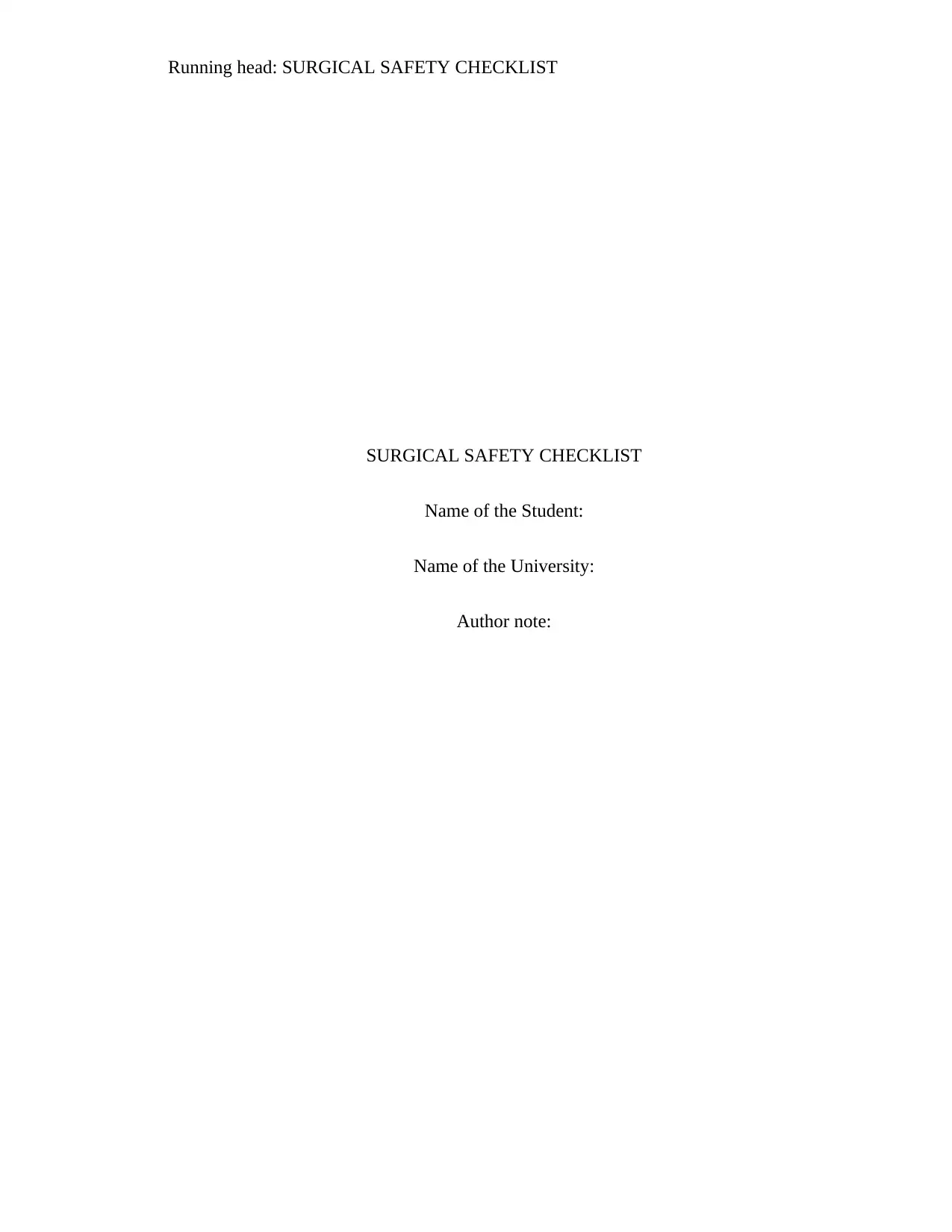
Running head: SURGICAL SAFETY CHECKLIST
SURGICAL SAFETY CHECKLIST
Name of the Student:
Name of the University:
Author note:
SURGICAL SAFETY CHECKLIST
Name of the Student:
Name of the University:
Author note:
Paraphrase This Document
Need a fresh take? Get an instant paraphrase of this document with our AI Paraphraser
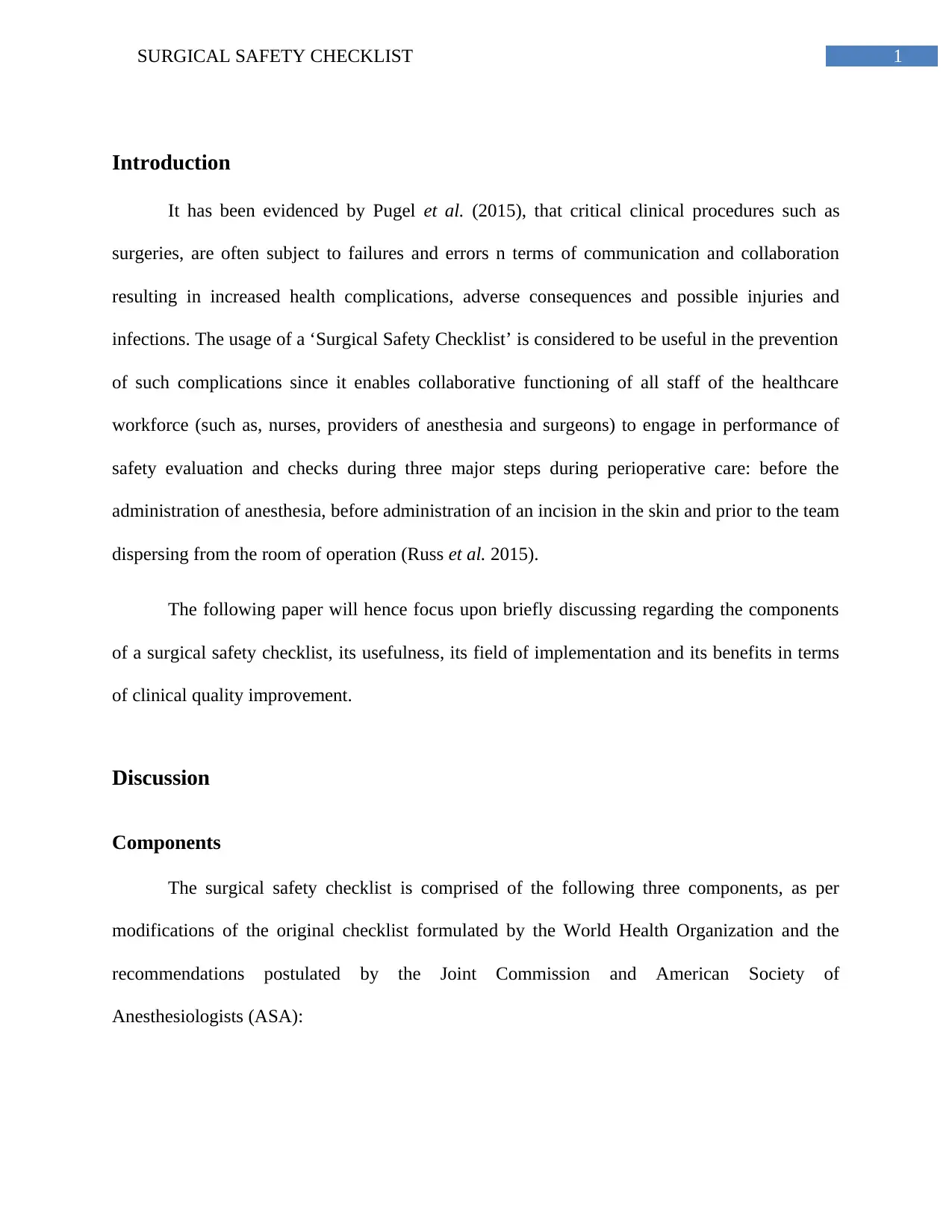
1SURGICAL SAFETY CHECKLIST
Introduction
It has been evidenced by Pugel et al. (2015), that critical clinical procedures such as
surgeries, are often subject to failures and errors n terms of communication and collaboration
resulting in increased health complications, adverse consequences and possible injuries and
infections. The usage of a ‘Surgical Safety Checklist’ is considered to be useful in the prevention
of such complications since it enables collaborative functioning of all staff of the healthcare
workforce (such as, nurses, providers of anesthesia and surgeons) to engage in performance of
safety evaluation and checks during three major steps during perioperative care: before the
administration of anesthesia, before administration of an incision in the skin and prior to the team
dispersing from the room of operation (Russ et al. 2015).
The following paper will hence focus upon briefly discussing regarding the components
of a surgical safety checklist, its usefulness, its field of implementation and its benefits in terms
of clinical quality improvement.
Discussion
Components
The surgical safety checklist is comprised of the following three components, as per
modifications of the original checklist formulated by the World Health Organization and the
recommendations postulated by the Joint Commission and American Society of
Anesthesiologists (ASA):
Introduction
It has been evidenced by Pugel et al. (2015), that critical clinical procedures such as
surgeries, are often subject to failures and errors n terms of communication and collaboration
resulting in increased health complications, adverse consequences and possible injuries and
infections. The usage of a ‘Surgical Safety Checklist’ is considered to be useful in the prevention
of such complications since it enables collaborative functioning of all staff of the healthcare
workforce (such as, nurses, providers of anesthesia and surgeons) to engage in performance of
safety evaluation and checks during three major steps during perioperative care: before the
administration of anesthesia, before administration of an incision in the skin and prior to the team
dispersing from the room of operation (Russ et al. 2015).
The following paper will hence focus upon briefly discussing regarding the components
of a surgical safety checklist, its usefulness, its field of implementation and its benefits in terms
of clinical quality improvement.
Discussion
Components
The surgical safety checklist is comprised of the following three components, as per
modifications of the original checklist formulated by the World Health Organization and the
recommendations postulated by the Joint Commission and American Society of
Anesthesiologists (ASA):
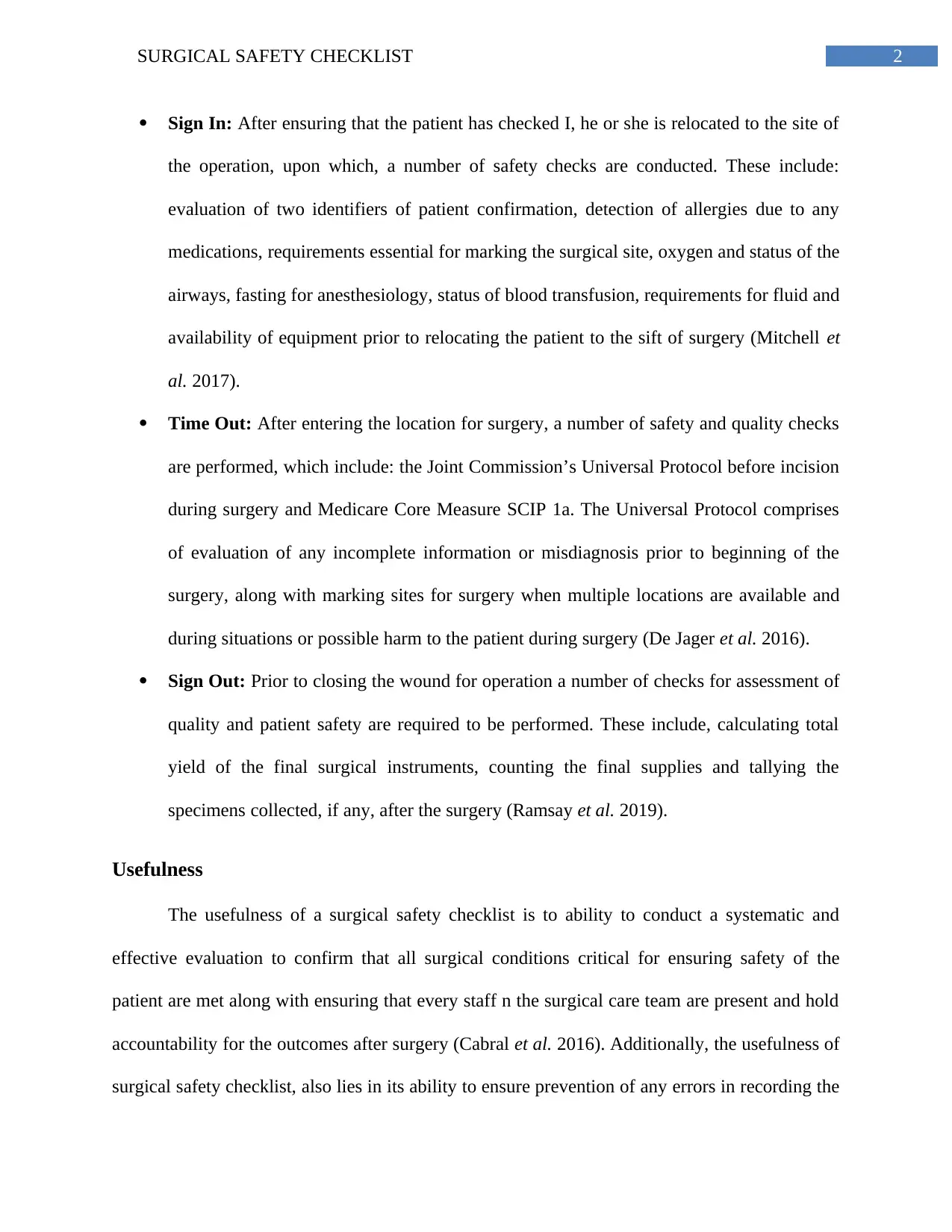
2SURGICAL SAFETY CHECKLIST
Sign In: After ensuring that the patient has checked I, he or she is relocated to the site of
the operation, upon which, a number of safety checks are conducted. These include:
evaluation of two identifiers of patient confirmation, detection of allergies due to any
medications, requirements essential for marking the surgical site, oxygen and status of the
airways, fasting for anesthesiology, status of blood transfusion, requirements for fluid and
availability of equipment prior to relocating the patient to the sift of surgery (Mitchell et
al. 2017).
Time Out: After entering the location for surgery, a number of safety and quality checks
are performed, which include: the Joint Commission’s Universal Protocol before incision
during surgery and Medicare Core Measure SCIP 1a. The Universal Protocol comprises
of evaluation of any incomplete information or misdiagnosis prior to beginning of the
surgery, along with marking sites for surgery when multiple locations are available and
during situations or possible harm to the patient during surgery (De Jager et al. 2016).
Sign Out: Prior to closing the wound for operation a number of checks for assessment of
quality and patient safety are required to be performed. These include, calculating total
yield of the final surgical instruments, counting the final supplies and tallying the
specimens collected, if any, after the surgery (Ramsay et al. 2019).
Usefulness
The usefulness of a surgical safety checklist is to ability to conduct a systematic and
effective evaluation to confirm that all surgical conditions critical for ensuring safety of the
patient are met along with ensuring that every staff n the surgical care team are present and hold
accountability for the outcomes after surgery (Cabral et al. 2016). Additionally, the usefulness of
surgical safety checklist, also lies in its ability to ensure prevention of any errors in recording the
Sign In: After ensuring that the patient has checked I, he or she is relocated to the site of
the operation, upon which, a number of safety checks are conducted. These include:
evaluation of two identifiers of patient confirmation, detection of allergies due to any
medications, requirements essential for marking the surgical site, oxygen and status of the
airways, fasting for anesthesiology, status of blood transfusion, requirements for fluid and
availability of equipment prior to relocating the patient to the sift of surgery (Mitchell et
al. 2017).
Time Out: After entering the location for surgery, a number of safety and quality checks
are performed, which include: the Joint Commission’s Universal Protocol before incision
during surgery and Medicare Core Measure SCIP 1a. The Universal Protocol comprises
of evaluation of any incomplete information or misdiagnosis prior to beginning of the
surgery, along with marking sites for surgery when multiple locations are available and
during situations or possible harm to the patient during surgery (De Jager et al. 2016).
Sign Out: Prior to closing the wound for operation a number of checks for assessment of
quality and patient safety are required to be performed. These include, calculating total
yield of the final surgical instruments, counting the final supplies and tallying the
specimens collected, if any, after the surgery (Ramsay et al. 2019).
Usefulness
The usefulness of a surgical safety checklist is to ability to conduct a systematic and
effective evaluation to confirm that all surgical conditions critical for ensuring safety of the
patient are met along with ensuring that every staff n the surgical care team are present and hold
accountability for the outcomes after surgery (Cabral et al. 2016). Additionally, the usefulness of
surgical safety checklist, also lies in its ability to ensure prevention of any errors in recording the
⊘ This is a preview!⊘
Do you want full access?
Subscribe today to unlock all pages.

Trusted by 1+ million students worldwide
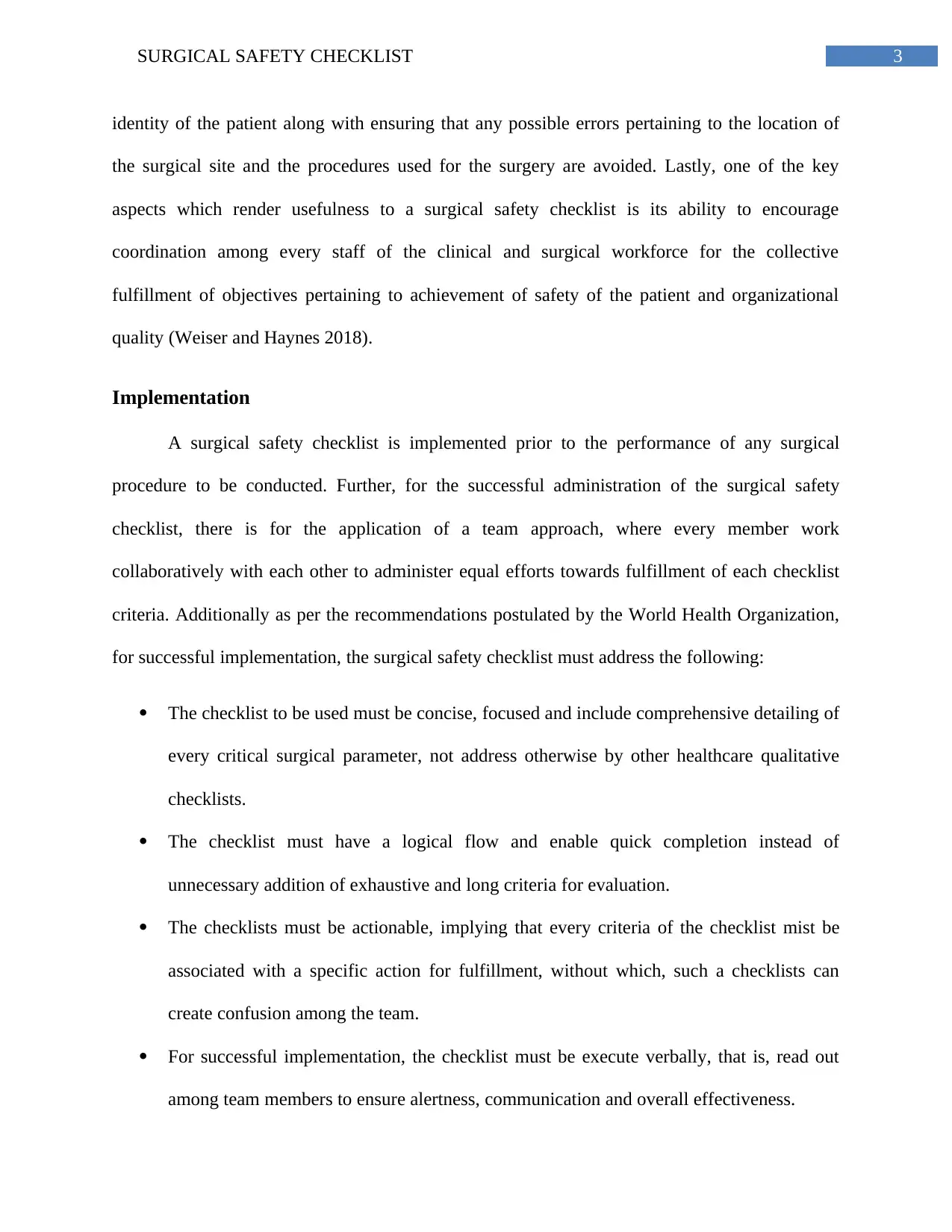
3SURGICAL SAFETY CHECKLIST
identity of the patient along with ensuring that any possible errors pertaining to the location of
the surgical site and the procedures used for the surgery are avoided. Lastly, one of the key
aspects which render usefulness to a surgical safety checklist is its ability to encourage
coordination among every staff of the clinical and surgical workforce for the collective
fulfillment of objectives pertaining to achievement of safety of the patient and organizational
quality (Weiser and Haynes 2018).
Implementation
A surgical safety checklist is implemented prior to the performance of any surgical
procedure to be conducted. Further, for the successful administration of the surgical safety
checklist, there is for the application of a team approach, where every member work
collaboratively with each other to administer equal efforts towards fulfillment of each checklist
criteria. Additionally as per the recommendations postulated by the World Health Organization,
for successful implementation, the surgical safety checklist must address the following:
The checklist to be used must be concise, focused and include comprehensive detailing of
every critical surgical parameter, not address otherwise by other healthcare qualitative
checklists.
The checklist must have a logical flow and enable quick completion instead of
unnecessary addition of exhaustive and long criteria for evaluation.
The checklists must be actionable, implying that every criteria of the checklist mist be
associated with a specific action for fulfillment, without which, such a checklists can
create confusion among the team.
For successful implementation, the checklist must be execute verbally, that is, read out
among team members to ensure alertness, communication and overall effectiveness.
identity of the patient along with ensuring that any possible errors pertaining to the location of
the surgical site and the procedures used for the surgery are avoided. Lastly, one of the key
aspects which render usefulness to a surgical safety checklist is its ability to encourage
coordination among every staff of the clinical and surgical workforce for the collective
fulfillment of objectives pertaining to achievement of safety of the patient and organizational
quality (Weiser and Haynes 2018).
Implementation
A surgical safety checklist is implemented prior to the performance of any surgical
procedure to be conducted. Further, for the successful administration of the surgical safety
checklist, there is for the application of a team approach, where every member work
collaboratively with each other to administer equal efforts towards fulfillment of each checklist
criteria. Additionally as per the recommendations postulated by the World Health Organization,
for successful implementation, the surgical safety checklist must address the following:
The checklist to be used must be concise, focused and include comprehensive detailing of
every critical surgical parameter, not address otherwise by other healthcare qualitative
checklists.
The checklist must have a logical flow and enable quick completion instead of
unnecessary addition of exhaustive and long criteria for evaluation.
The checklists must be actionable, implying that every criteria of the checklist mist be
associated with a specific action for fulfillment, without which, such a checklists can
create confusion among the team.
For successful implementation, the checklist must be execute verbally, that is, read out
among team members to ensure alertness, communication and overall effectiveness.
Paraphrase This Document
Need a fresh take? Get an instant paraphrase of this document with our AI Paraphraser
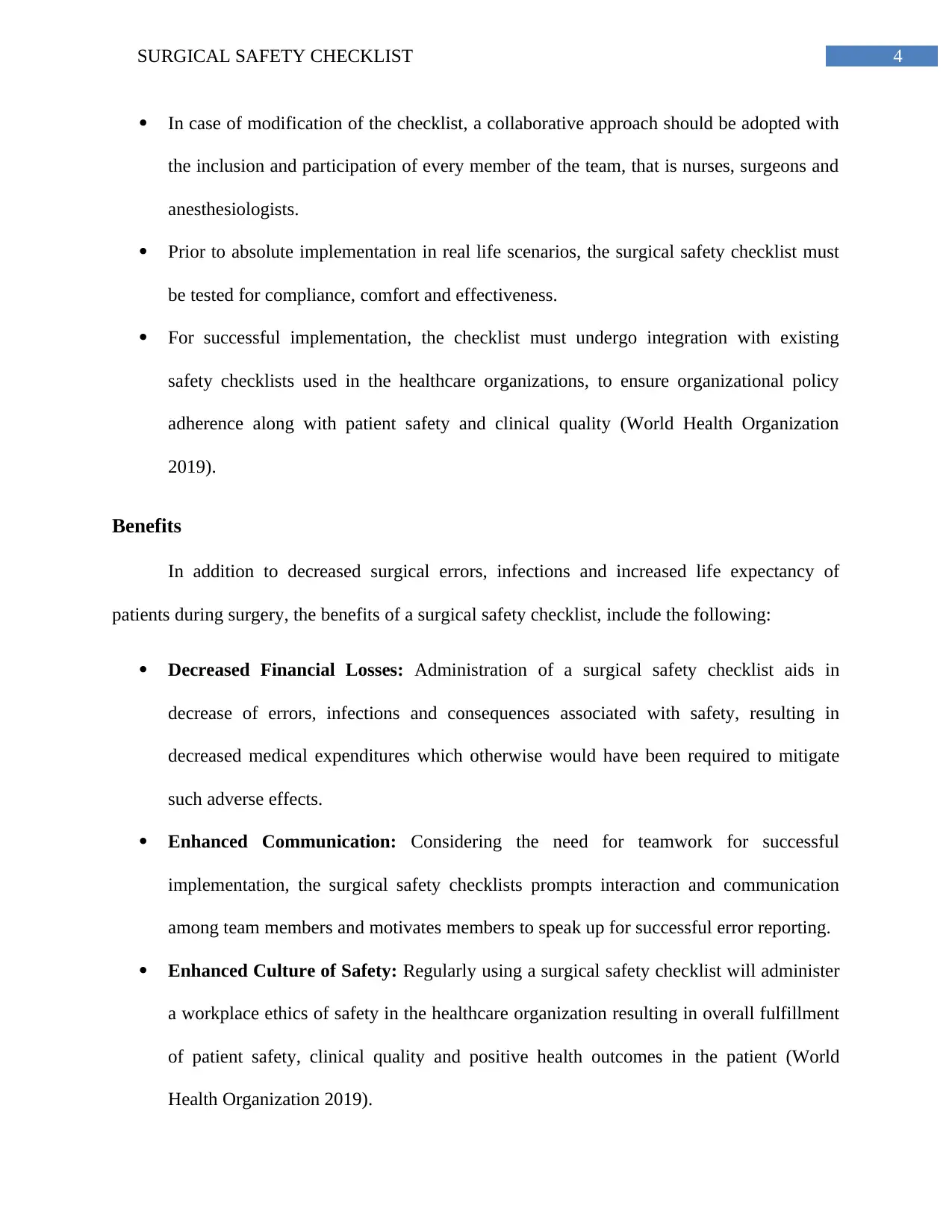
4SURGICAL SAFETY CHECKLIST
In case of modification of the checklist, a collaborative approach should be adopted with
the inclusion and participation of every member of the team, that is nurses, surgeons and
anesthesiologists.
Prior to absolute implementation in real life scenarios, the surgical safety checklist must
be tested for compliance, comfort and effectiveness.
For successful implementation, the checklist must undergo integration with existing
safety checklists used in the healthcare organizations, to ensure organizational policy
adherence along with patient safety and clinical quality (World Health Organization
2019).
Benefits
In addition to decreased surgical errors, infections and increased life expectancy of
patients during surgery, the benefits of a surgical safety checklist, include the following:
Decreased Financial Losses: Administration of a surgical safety checklist aids in
decrease of errors, infections and consequences associated with safety, resulting in
decreased medical expenditures which otherwise would have been required to mitigate
such adverse effects.
Enhanced Communication: Considering the need for teamwork for successful
implementation, the surgical safety checklists prompts interaction and communication
among team members and motivates members to speak up for successful error reporting.
Enhanced Culture of Safety: Regularly using a surgical safety checklist will administer
a workplace ethics of safety in the healthcare organization resulting in overall fulfillment
of patient safety, clinical quality and positive health outcomes in the patient (World
Health Organization 2019).
In case of modification of the checklist, a collaborative approach should be adopted with
the inclusion and participation of every member of the team, that is nurses, surgeons and
anesthesiologists.
Prior to absolute implementation in real life scenarios, the surgical safety checklist must
be tested for compliance, comfort and effectiveness.
For successful implementation, the checklist must undergo integration with existing
safety checklists used in the healthcare organizations, to ensure organizational policy
adherence along with patient safety and clinical quality (World Health Organization
2019).
Benefits
In addition to decreased surgical errors, infections and increased life expectancy of
patients during surgery, the benefits of a surgical safety checklist, include the following:
Decreased Financial Losses: Administration of a surgical safety checklist aids in
decrease of errors, infections and consequences associated with safety, resulting in
decreased medical expenditures which otherwise would have been required to mitigate
such adverse effects.
Enhanced Communication: Considering the need for teamwork for successful
implementation, the surgical safety checklists prompts interaction and communication
among team members and motivates members to speak up for successful error reporting.
Enhanced Culture of Safety: Regularly using a surgical safety checklist will administer
a workplace ethics of safety in the healthcare organization resulting in overall fulfillment
of patient safety, clinical quality and positive health outcomes in the patient (World
Health Organization 2019).
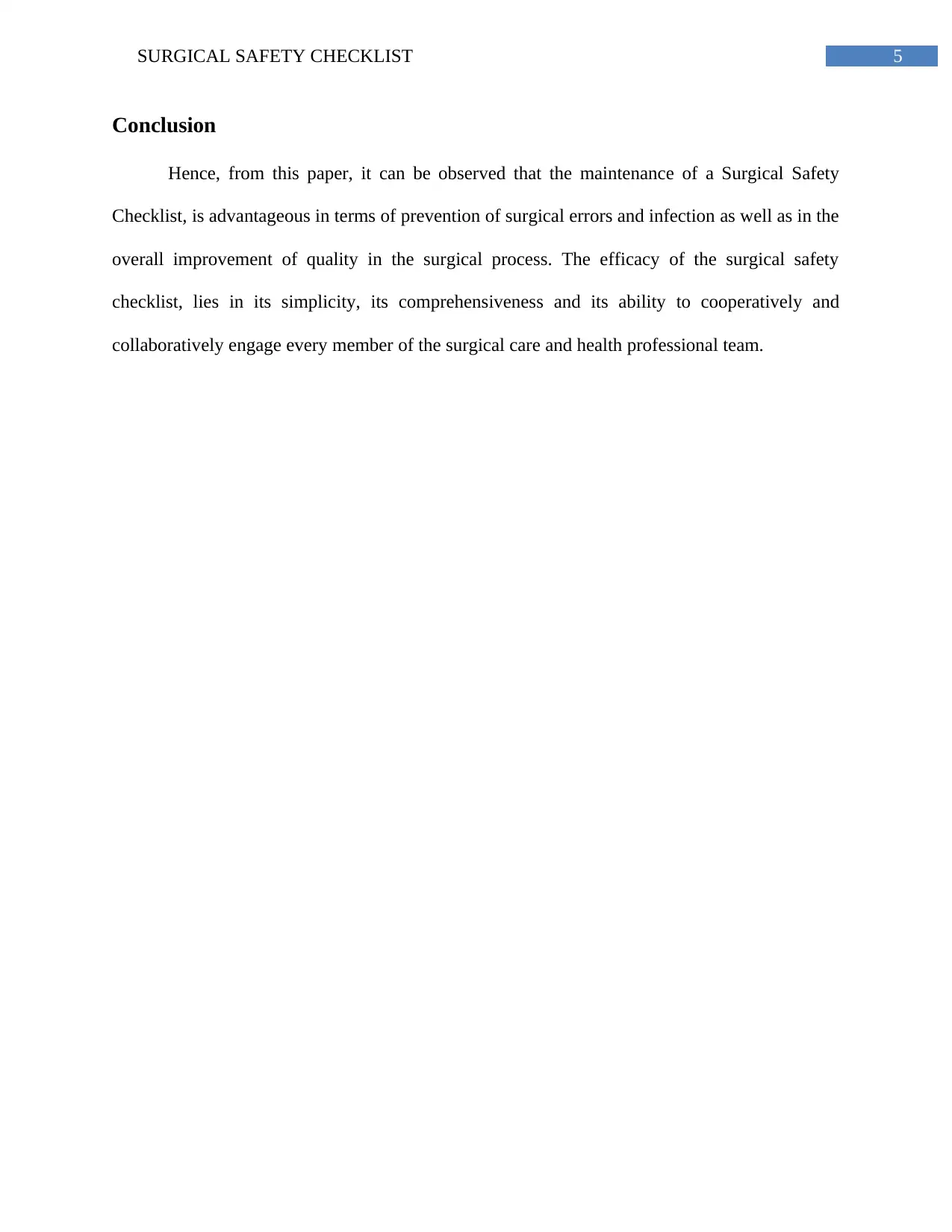
5SURGICAL SAFETY CHECKLIST
Conclusion
Hence, from this paper, it can be observed that the maintenance of a Surgical Safety
Checklist, is advantageous in terms of prevention of surgical errors and infection as well as in the
overall improvement of quality in the surgical process. The efficacy of the surgical safety
checklist, lies in its simplicity, its comprehensiveness and its ability to cooperatively and
collaboratively engage every member of the surgical care and health professional team.
Conclusion
Hence, from this paper, it can be observed that the maintenance of a Surgical Safety
Checklist, is advantageous in terms of prevention of surgical errors and infection as well as in the
overall improvement of quality in the surgical process. The efficacy of the surgical safety
checklist, lies in its simplicity, its comprehensiveness and its ability to cooperatively and
collaboratively engage every member of the surgical care and health professional team.
⊘ This is a preview!⊘
Do you want full access?
Subscribe today to unlock all pages.

Trusted by 1+ million students worldwide
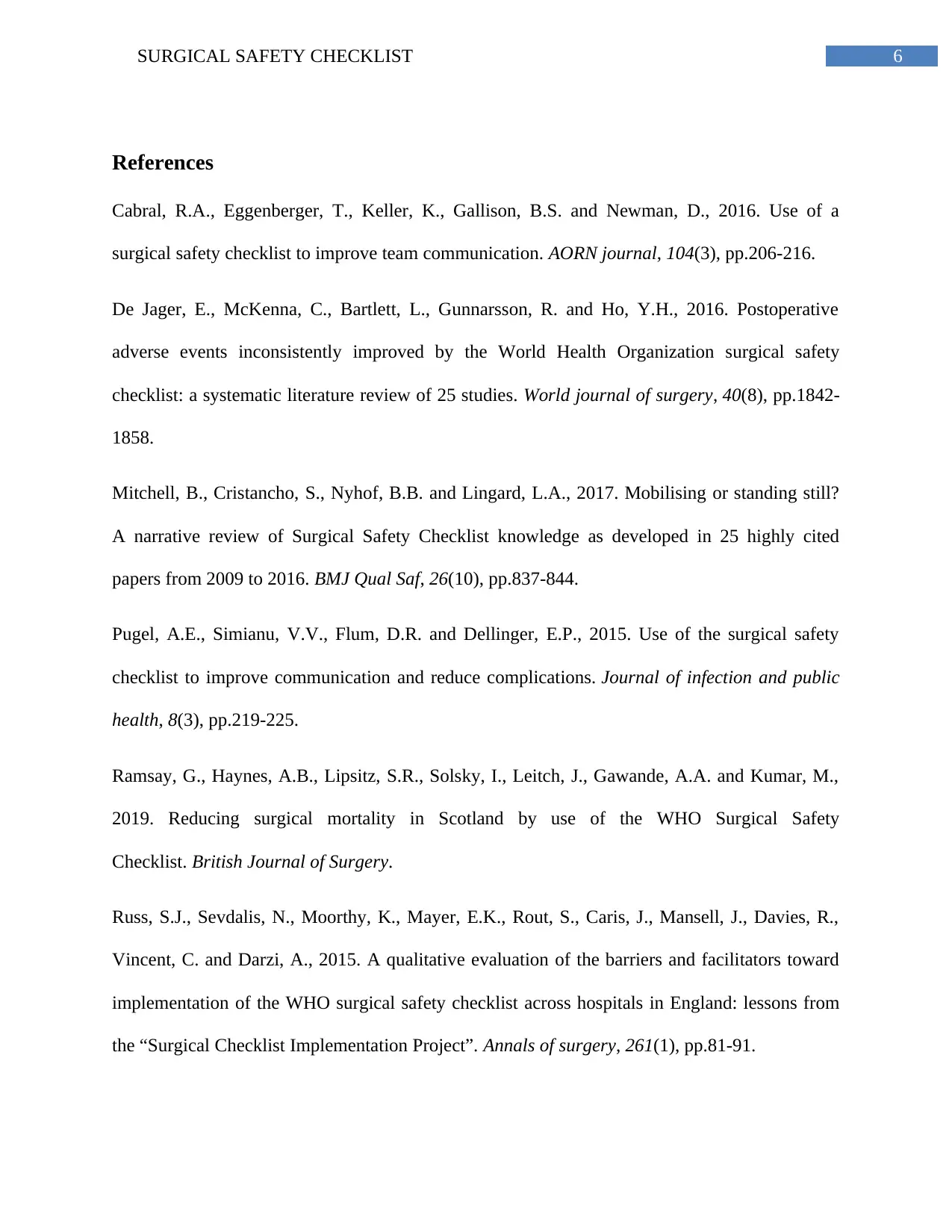
6SURGICAL SAFETY CHECKLIST
References
Cabral, R.A., Eggenberger, T., Keller, K., Gallison, B.S. and Newman, D., 2016. Use of a
surgical safety checklist to improve team communication. AORN journal, 104(3), pp.206-216.
De Jager, E., McKenna, C., Bartlett, L., Gunnarsson, R. and Ho, Y.H., 2016. Postoperative
adverse events inconsistently improved by the World Health Organization surgical safety
checklist: a systematic literature review of 25 studies. World journal of surgery, 40(8), pp.1842-
1858.
Mitchell, B., Cristancho, S., Nyhof, B.B. and Lingard, L.A., 2017. Mobilising or standing still?
A narrative review of Surgical Safety Checklist knowledge as developed in 25 highly cited
papers from 2009 to 2016. BMJ Qual Saf, 26(10), pp.837-844.
Pugel, A.E., Simianu, V.V., Flum, D.R. and Dellinger, E.P., 2015. Use of the surgical safety
checklist to improve communication and reduce complications. Journal of infection and public
health, 8(3), pp.219-225.
Ramsay, G., Haynes, A.B., Lipsitz, S.R., Solsky, I., Leitch, J., Gawande, A.A. and Kumar, M.,
2019. Reducing surgical mortality in Scotland by use of the WHO Surgical Safety
Checklist. British Journal of Surgery.
Russ, S.J., Sevdalis, N., Moorthy, K., Mayer, E.K., Rout, S., Caris, J., Mansell, J., Davies, R.,
Vincent, C. and Darzi, A., 2015. A qualitative evaluation of the barriers and facilitators toward
implementation of the WHO surgical safety checklist across hospitals in England: lessons from
the “Surgical Checklist Implementation Project”. Annals of surgery, 261(1), pp.81-91.
References
Cabral, R.A., Eggenberger, T., Keller, K., Gallison, B.S. and Newman, D., 2016. Use of a
surgical safety checklist to improve team communication. AORN journal, 104(3), pp.206-216.
De Jager, E., McKenna, C., Bartlett, L., Gunnarsson, R. and Ho, Y.H., 2016. Postoperative
adverse events inconsistently improved by the World Health Organization surgical safety
checklist: a systematic literature review of 25 studies. World journal of surgery, 40(8), pp.1842-
1858.
Mitchell, B., Cristancho, S., Nyhof, B.B. and Lingard, L.A., 2017. Mobilising or standing still?
A narrative review of Surgical Safety Checklist knowledge as developed in 25 highly cited
papers from 2009 to 2016. BMJ Qual Saf, 26(10), pp.837-844.
Pugel, A.E., Simianu, V.V., Flum, D.R. and Dellinger, E.P., 2015. Use of the surgical safety
checklist to improve communication and reduce complications. Journal of infection and public
health, 8(3), pp.219-225.
Ramsay, G., Haynes, A.B., Lipsitz, S.R., Solsky, I., Leitch, J., Gawande, A.A. and Kumar, M.,
2019. Reducing surgical mortality in Scotland by use of the WHO Surgical Safety
Checklist. British Journal of Surgery.
Russ, S.J., Sevdalis, N., Moorthy, K., Mayer, E.K., Rout, S., Caris, J., Mansell, J., Davies, R.,
Vincent, C. and Darzi, A., 2015. A qualitative evaluation of the barriers and facilitators toward
implementation of the WHO surgical safety checklist across hospitals in England: lessons from
the “Surgical Checklist Implementation Project”. Annals of surgery, 261(1), pp.81-91.
Paraphrase This Document
Need a fresh take? Get an instant paraphrase of this document with our AI Paraphraser
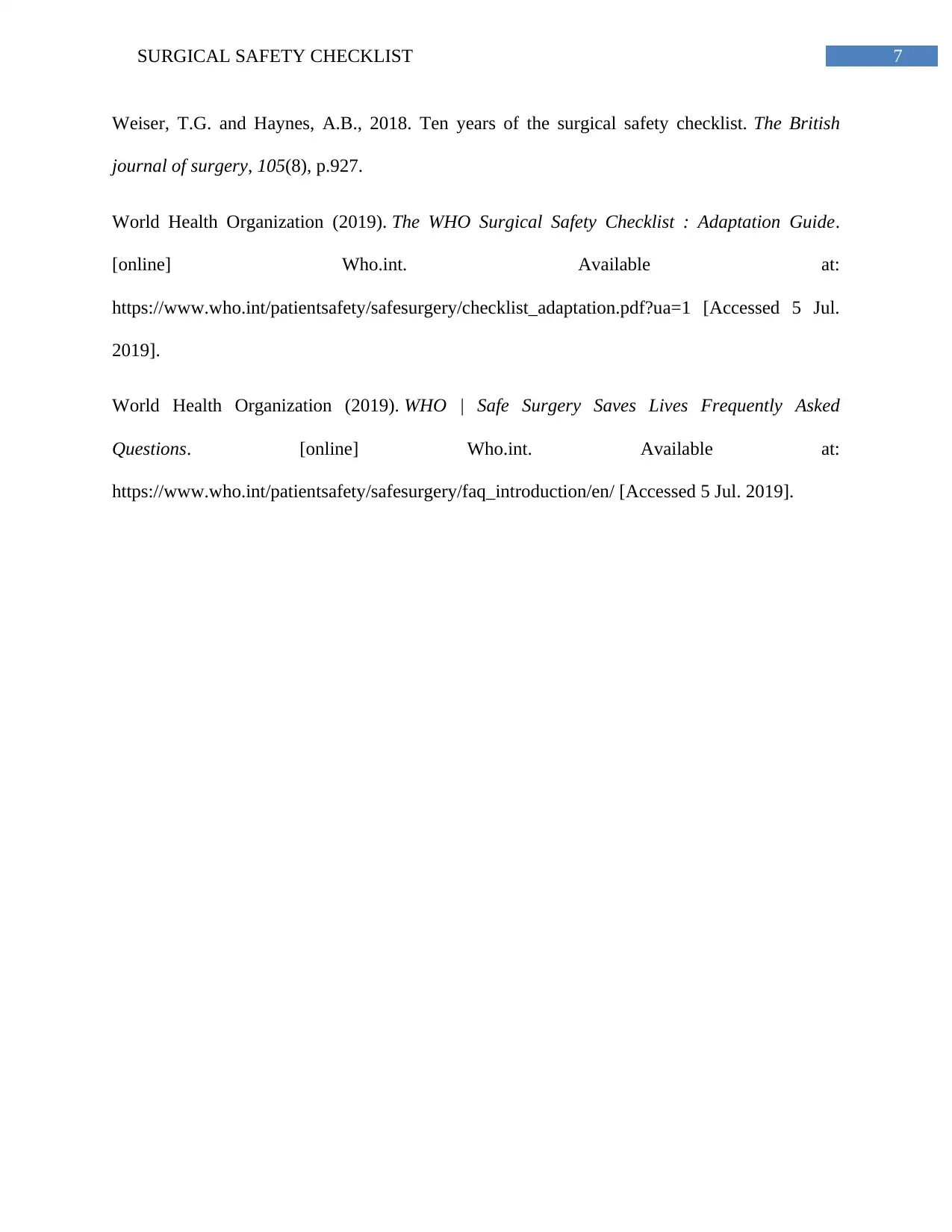
7SURGICAL SAFETY CHECKLIST
Weiser, T.G. and Haynes, A.B., 2018. Ten years of the surgical safety checklist. The British
journal of surgery, 105(8), p.927.
World Health Organization (2019). The WHO Surgical Safety Checklist : Adaptation Guide.
[online] Who.int. Available at:
https://www.who.int/patientsafety/safesurgery/checklist_adaptation.pdf?ua=1 [Accessed 5 Jul.
2019].
World Health Organization (2019). WHO | Safe Surgery Saves Lives Frequently Asked
Questions. [online] Who.int. Available at:
https://www.who.int/patientsafety/safesurgery/faq_introduction/en/ [Accessed 5 Jul. 2019].
Weiser, T.G. and Haynes, A.B., 2018. Ten years of the surgical safety checklist. The British
journal of surgery, 105(8), p.927.
World Health Organization (2019). The WHO Surgical Safety Checklist : Adaptation Guide.
[online] Who.int. Available at:
https://www.who.int/patientsafety/safesurgery/checklist_adaptation.pdf?ua=1 [Accessed 5 Jul.
2019].
World Health Organization (2019). WHO | Safe Surgery Saves Lives Frequently Asked
Questions. [online] Who.int. Available at:
https://www.who.int/patientsafety/safesurgery/faq_introduction/en/ [Accessed 5 Jul. 2019].
1 out of 8
Related Documents
Your All-in-One AI-Powered Toolkit for Academic Success.
+13062052269
info@desklib.com
Available 24*7 on WhatsApp / Email
![[object Object]](/_next/static/media/star-bottom.7253800d.svg)
Unlock your academic potential
Copyright © 2020–2025 A2Z Services. All Rights Reserved. Developed and managed by ZUCOL.





